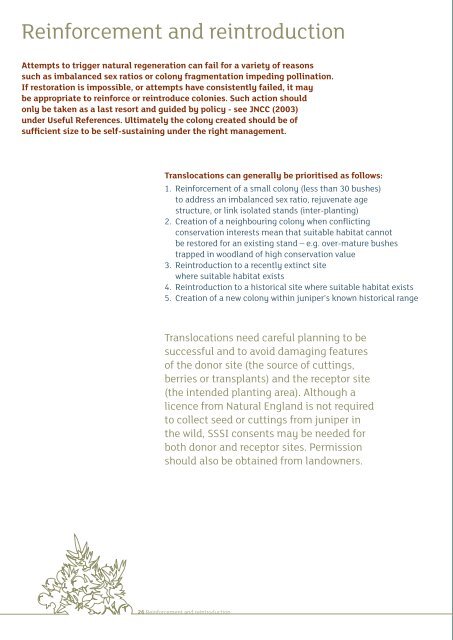Breaking new ground for juniper - Plantlife
Breaking new ground for juniper - Plantlife
Breaking new ground for juniper - Plantlife
- No tags were found...
Create successful ePaper yourself
Turn your PDF publications into a flip-book with our unique Google optimized e-Paper software.
Rein<strong>for</strong>cement and reintroductionAttempts to trigger natural regeneration can fail <strong>for</strong> a variety of reasonssuch as imbalanced sex ratios or colony fragmentation impeding pollination.If restoration is impossible, or attempts have consistently failed, it maybe appropriate to rein<strong>for</strong>ce or reintroduce colonies. Such action shouldonly be taken as a last resort and guided by policy - see JNCC (2003)under Useful References. Ultimately the colony created should be ofsufficient size to be self-sustaining under the right management.Translocations can generally be prioritised as follows:1. Rein<strong>for</strong>cement of a small colony (less than 30 bushes)to address an imbalanced sex ratio, rejuvenate agestructure, or link isolated stands (inter-planting)2. Creation of a neighbouring colony when conflictingconservation interests mean that suitable habitat cannotbe restored <strong>for</strong> an existing stand – e.g. over-mature bushestrapped in woodland of high conservation value3. Reintroduction to a recently extinct sitewhere suitable habitat exists4. Reintroduction to a historical site where suitable habitat exists5. Creation of a <strong>new</strong> colony within <strong>juniper</strong>’s known historical rangeTranslocations need careful planning to besuccessful and to avoid damaging featuresof the donor site (the source of cuttings,berries or transplants) and the receptor site(the intended planting area). Although alicence from Natural England is not requiredto collect seed or cuttings from <strong>juniper</strong> inthe wild, SSSI consents may be needed <strong>for</strong>both donor and receptor sites. Permissionshould also be obtained from landowners.Site reintroduction should only beconsidered once the causes of loss havebeen identified and resolved. In caseswhere the original habitat has beenaltogether lost, severely damaged oris beyond restoration, an alternativenearby site should be sought.Early consideration should be given to thesuitability of habitat at the intended plantingsite. Areas recently cleared of mixed scrub/woodland are unsuitable unless woody re-growthhas been successfully controlled, or a scrapehas been created. Potentially suitable plantinghabitat includes: stock-grazed grassland, exarablefields (impoverished soils only) anddisused quarries (with compatible after-use).The receptor site should be agreed by allstakeholders well in advance of planting outPropagation takes time: cuttings will need atleast two years growth be<strong>for</strong>e they are ready <strong>for</strong>planting; seeds can take five or more years due totheir inherent dormancy. Populations with low seedviability (Box 2) are better suited to propagationfrom cuttings. Cuttings are quicker growing butcan have high failure rates and result in clonesof parent bushes. Seedlings tend to have greatergenetic diversity but seed is slow to germinateand seedlings slow to develop. As neither methodis straight<strong>for</strong>ward, higher success rates may beattained through a specialist tree nursery.For larger projects a combination of plants fromcuttings and seed is probably the best strategy,giving tangible results early on, whilst improvingthe future genetic diversity of the population.Aim to create a colony of at least 30 mixedsexindividuals, including any existing bushes,as this is thought to constitute a geneticallyrobust population. Recovery may be expeditedby introducing a higher proportion of females –e.g. a sex ratio of 3 females to 2 males (note thatfemale <strong>juniper</strong>s tend to die earlier than males).To help you determine whether reintroduction orrein<strong>for</strong>cement is suitable <strong>for</strong> the recipient site, thesections below begin with a checklist of desirableattributes. The following are additional to these:• Reasons <strong>for</strong> past decline identified and resolved• Open habitat with at least 10% bare-<strong>ground</strong> cover• Extensively cattle grazed most of thetime; occasional mob-grazing feasible• Low/controlled browsing pressurefrom rabbits and deer• 10 year aftercare plan feasible• Skeletal soils (poor and thin)• Open sloping land (unshaded)• Low risk of mixed scrub encroachment• Lack of tall grassland in the vicinity(field vole habitat)• Presence or records of other importantearly successional species• Other site features uncompromised(biodiversity, archaeological, amenity, etc)26 Rein<strong>for</strong>cement and reintroduction <strong>Breaking</strong> <strong>new</strong> <strong>ground</strong> <strong>for</strong> lowland <strong>juniper</strong> 27
















